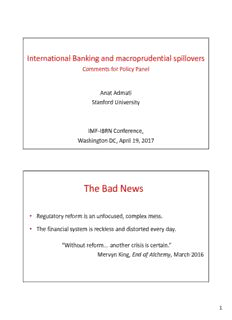
Anat Admati PDF
Preview Anat Admati
International Banking and macroprudential spillovers Comments for Policy Panel Anat Admati Stanford University IMF‐IBRN Conference, Washington DC, April 19, 2017 The Bad News • Regulatory reform is an unfocused, complex mess. • The financial system is reckless and distorted every day. “Without reform... another crisis is certain.” Mervyn King, End of Alchemy, March 2016 1 2 “Macroprudential” • Fuzzy concept, multiple goals; e.g., – Protect the financial system from macroeconomic shocks – Monitor “systemic risk” arising from the financial sector that can harm the broader economy – Prevent “asset price bubbles” and excessive credit • Macroprudential vs microprudential is false dichotomy. – Well‐designed microprudential regulations can achieve many macroprudential policy goals. – Effective microprudential tools are “regulatory bargains.” Heavy Indebtedness Causes Great Inefficiencies and Collateral Harm • True for households, hence LTV, DTI regulations can be useful. • Subsidizing mortgage debt and corporate debt relative to equity is bad, distortive policy that should change. – Tax and other debt subsidies for housing and for corporations are distortive and inefficient, particularly perverse for banks. • Heavily indebted corporations, including banks, make inefficient investment and funding decisions. – Excessive risk taking and use of debt (“addiction”). – Underinvestment in worthy projects and leverage reduction. 3 T L R E HE EVERAGE ATCHET FFECT (Forthcoming Journal of Finance) Anat Admati Martin Hellwig Stanford Max Planck Peter DeMarzo Paul Pfleiderer Stanford Stanford Shareholders’ Preferences For Leverage Reduction Homogeneous assets, NPV = 0 for asset transactions Main conflict is between shareholders and senior creditors. Key result (many more): Adjustment to “ratio” may be inefficient! Debt Type Bought Asset Liquidation Pure Recapitalization Asset Expansion (A and B) Homogeneous Senior Debt Junior Debt 8 4 Size of 28 Global Banks 2006: $37.8 trillion total 2013: $49.2 trillion total Average Average $1.35 trillion $1.76trillion Sources: SNL Financial, FDIC, bank annual reports, Bank of England calculations. Derivatives for 21 Banks 2006: $409 trillion (notional) 2013: $661 trillion (notional) Average Average $31 trillion $19 trillion Sources: SNL Financial, FDIC, bank annual reports, Bank of England calculations. 5 Large Banks are Opaque “banking remains too much of a black box... for many investors scarcely an investible proposition.” Andrew Haldane, BoE, Nov 2011 “Investors can’t understand the nature and quality of the assets and liabilities... The disclosure obfuscates more than it informs.” Kevin Warsh, Jan. 2013 “The unfathomable nature of banks’ public accounts make it impossible to know which are actually risky or sound. Derivatives positions, in particular, are difficult for outside investors to parse.” Paul Singer, Jan. 2014 “Shadow Banking,” Pozsar, Adrian, Ashcraft and Boesky, 2010 (Often the same institutions, complex for private reasons) 6 “ Too Big to Fail” and Complex System are Symptoms • It’s not just about crises or bailouts – System is inefficient and distorted every day. – “Fail” can cause collateral harm whoever pays direct cost. • It’s about basic accountability, governance and public safety – Do we allow reckless speed if “industry” pays for ambulances? – Private gains and social losses = crony capitalism – Pure subsidy extraction should not be a viable business model • Bad system, boom, bust and crises are “unintended consequence” of distorted incentives and ineffective regulations “Let Them Fail?” • FSB 2014 “Key Attribute of Cross‐Border Resolution” includes huge wish‐list of legal and regulatory steps. • IMF 2014: failure of cross‐border SIFI “not a viable option” • Conversion of TLAC to equity only in resolution, requires determination of insolvency. By whom? 7 Too complex to Resolve? Dexia's structure Associated Dexia Dexia SA (DSA) Technology DBNL Services (ADTS) DCL Paris 100% Belgium 100% Belgium 100% Netherlands DenizBank DCL London DHI Branch CCBBXXB aIIAAn12q uSSeAA,RR LL,, Dexia C(DreCdLi)t Local FDuCndLi nGglo (bGaFl ) HoldD(DienHxgiIsa) Inc DexiaFP (FP) BeDlgexiuiam B (aDnBkB ) LIunDxteeexmrniaba otBiuoarnngaq l(ueBe Ia L ) DenizBank (DzB) Banque, 100% Belgium 100% US 100% Belgium 100% France 99.8% Belgium 99.8% Luxembourg 99.8% Turkey DCL France De(xCiare Cdrioedpi)op De(xSiaa bSaadbeelld)ell KoDmeum(DtDsueKcxnhDiaal)la bnadn k DAegxeiancMyu (nDicMipAa)l subOsitdhiearr ies BeInlgsDiuuermxai na(cD eIB ) MDaenx(DaiagA eAMms)seentt RSIB(nReCvrBev DCsicteDeox)sri a Deniz(DEzmEe)klilik 70% Italy 60% Spain 100% Germany 100% France 100% Various 99.8% Belgium 100% Belgium 50% Belgium 100% Turkey DCL France ‐Dublin Isnutebrsnidaitaiorineasl DCL East FSruebnscihd iSamrieasll DCbLra Dnucbhlin DCCLCD LhFCFurLS oaB P TnMaoVnciktqesyuuoei 100%(EDMSDsDPLeeae(txMVoaDeranxCviDccxatRiaaaeihaiairec rgfaE PiilikxCeCone cCAaReisuama raPctMs ee)pssLieitdaf)i aytntilidca tt l / DLCoDDdcLCCeDae bbxAl aLC CrriMaaay mVLGemnnC x(rNccDreaiaechhYCnrndoL i id tSc Aa DDFe(CSDul(DaDbeneLDewcexrd xuaCxieiaanirinxaaarigCticeni aUeLUAh aLsSLDSd)L C aC KBDoDamVKnCaVmBk(DLriD eu sAe PnnCIoxGsnoaivL arell(kias D)erekCe)ladLi t SoSfIaSxLis DoFDmloSeibxsAieaarilve 1D00Ro%DemBgei+aixsoiielanFrrsva enceEDxetxeirailmBmaoil dImuLrlmooeDCceJneoaLV,gx bt(F)uioLaie liL ni eDr- (DMS UK) Mexico) Securities) “Fail” is Too Late, Too Costly Can we do more to prevent it at reasonable cost? YES!! (and get more benefits besides) 8 An ounce of prevention is worth a pound of cure Solvent? A loss Equity Equity Debt Asset Asset Promises Debt Value Value Promises Too Little More Equity Equity Equity Bailout Equity Debt DISTRESS Assets Assets Debt DAMAGE TO After After THE ECONOMY Too Little More Equity Equity 9 Total Liabilities and Equity of Barclays 1992‐07 From: Hyun Song Shin, “Global Banking Glut and Loan Risk Premium,” IMF Annual Research Conference, November 10-11, 2011; Figure 22. JPMorgan Chase Balance Sheet IFRS Total $4.06 Trillion Dec. 31, 2011 Cash Loans Deposits Loans = $700B less than Deposits = $1.1T GAAP Total $2.26Trillion Other debt (GAAP): $1T Cash Other Other debt (IFRS): $1.8T Debt Loans Trading and (mostly Deposits Other short‐term) Assets Equity (book): $184B Equity (market): $126B Trading and Other Debt Other (mostly Assets short‐term) Significant off‐balance‐sheet Long‐Term Long‐Term Debt Debt Equity Equity commitments 10
Description: